
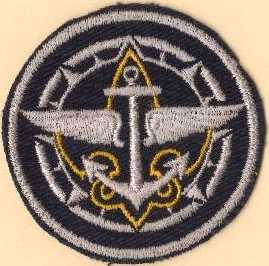
 |
Senior Scouts (1935-1949) |  |
These programs included:
Explorer Scouting was developed in the west as parallel program to Sea Scouts starting around 1922. Its emphasis was on advanced outdoor work in camping, hiking, and exploring. Early years the program did not have a good focus, but in later years it became better organized as a program. Go to the Explorer Scouts page for the full story.
Air Scouting was established later on, in 1941. With the advent of World War II, aircraft became more prominent, and to tie into this, the Air Scout program was created. It took its inspiration from the Air Force, much in the same way the Sea Scouts were inspired by Naval tradition. Go to the Air Scouts page to learn more.
Rover Scouting is one of the lesser known programs of the Senior Scout programs. It is based on a program created by B-P for the oldest of boys, and sprang up within the BSA by 1928. It is a service and leadership based program for boys 17 and older. National gave this program little support, and so it was always fairly small. Eventually it would end after a couple of decades. To find out what little is know, go to the Rover Scouts page.
Troop Alumni was a loose way to keep past members of a troop together and to help support the troop in leadership, sponsorship, and financially, much like college alumni. This was never a very well defined program, and so was eventually dropped. This idea lives on in the loose concept of Scouting Alumni programs with National.
Senior Scouting in the Troop allowed for the use of Senior Scout programs (Sea, Air, Explorer Scouting) within a Troop structure to keep older boys involved in a troop, rather then pull them away to separate units. In various forms, this basic idea would continue to this day. The Senior Scouting in the Troop page begins this story, and links it to those programs that followed it.
Press Clubs was not a widespread or very organized program. It came about from the inclusion of the Lone Scouts of America organization and its use of journalistic activities of its members to keep the program going. Press Clubs officially existed from 1930 to 1956. The program was aimed at those boys who were interested in journalism and writing, to help serve their units and councils with their articles and writings. An insignia pin was available.
Order of the Arrow was established in 1915 in the Philadelphia Council as a summer camp honor society. The OA would grow to be one of the largest of such groups (there were many all across the council, some only existing in one council, but a handful existed in many). The OA was dedicated to promoting camping and supporting council camp properties, and instilling in its membership the principles of Brotherhood, Cheerfulness, and Service. The National office approved the OA as part of the program in 1935, but didn't make it an official part of the BSA until 1948. Today it serves as the BSA's National Honor Society. To learn more about the OA, go to their official web site. To learn more about the other honor societies, go here.
Knights of Dunamis was established in 1925 in San Francisco. It was basically a fraternal service organization limited to Eagle Scouts, but later allowed those who had earned the Quartermaster, Ace, Ranger, or Silver Awards to join. Chapters soon spread across the country. In 1934, in came under the Senior program, and in 1967 it became part of the BSA program. In 1971, it became the National Eagle Scout Association, loosing its fraternal character. To learn more about NESA and the Knights, go to the official NESA page at National's web site.
Senior Degree Honor Society is probably one of the least known of all the programs within the Senior Scouting programs. It was a fraternal scouting honor society aimed at developing leadership among older boys. It was established in 1917 in New Jersey, and chapters spread to a few other councils. It came under the auspices of the National office when it became part of the Senior Scouting programs. To find out what little is know about it, go to the Senior Degree Honor Society page.
Scouting Group
The idea of the Senior Scout programs also tied into the idea
of creating a progression for boys going through the overall scouting
program.
In some countries each of these programs are called sections. In
the BSA this was viewed as the Scouting Group, but was not emphasized
as
much. The progression went something like this:
Cub Scouts (10-11)
Boy Scouts (11-17)
Senior Scouts (15-17)
Rover Scouts (17-25)
Troop Alumni (25-on)
But this idea really didn't catch on as hoped. It part it could have been caused by the overlapping of ages. In most countries, a boy at 15 had little choice but to move over to their equivalent of our Senior Scouting programs. They could not stay in Boy Scouts. Then when they became 17, they would move into Rovers. In the BSA, the overlapping of ages meant the boys didn't necessarily have to move over.
Due to research conducted by National, in September 1949, the Senior Scout programs became the Explorer programs. Explorer Scouts became Explorers. Sea Scouts became Sea Explorers. Air Scouts became Air Explorers. Some of the other Senior Scout programs continued, others were changed or eventually dropped.
Senior Scout Uniforms
Each program within Senior Scouts had their own uniform. At
first,
Senior Scouts would wear the standard Boy Scout khaki uniforms, but
with
ties and different shirt strips. Only adults wore ties, youth
wore
neckerchiefs, so having Senior Scouts wear ties set them off from other
youth. Adult Scouters wore tan ties, whereas Explorers Scouts wore
maroon
ties. I assume this was true for any Senior Scout in a troop. For
Senior Scouts in troops, there was a Senior Scout shirt strip on khaki.
Around 1941 a Senior Scout fatigue uniform was developed. It consisted of blue dungarees (jeans), a white T-shirt with the Senior Scout logo, blue fatigue cap and blue zipper jacket with a Senior Scouting strip. This fatigue uniform continued for awhile under the Explorer program after 1949.

Senior Scout Titles
For the most part, each of the Senior Scout programs had their own
program of advancement. The closest things to an overall
advancement
program for all the Senior Scout programs were Senior Scout
Titles.
The purpose of the Titles was to go beyond the idea of merit badges for
something aimed at the needs and interests of the older boy. The
concept was to get the boy to specialize in an area that may lead to a
lifetime interest or career.
To earn a title, the Senior Scout would develop a plan that involved earned at least 5 merit badges for the title's field, doing advanced work in one or more of those merit badge subjects beyond the Merit Badge Requirements, and plan and carry out a service project in that field involving the skills learning in earning the merit badges. For detailed requirements and merit badge fields, go here.
Initially 10 titles were created: Artisan, Artist, Citizen, Craftsman, Woodsman (later called Forester), Journalist, Naturalist, Radioman, Seaman, and Sportsman. In 1942, six additional titles in rural fields were added: Conservartionalist, Dairyman, Farm Manager, Gardener, Livestockman, and Poultryman. In 1943, the Airman title was added with the Air Scout program's introduction.
These titles would be worn around the Senior Scouting program emblems (Senior Scout, Explorer Scout, Sea Scout, Air Scout, Rover Scout) worn on the right sleeve. Initially, they were made on khaki green twill and navy blue felt for the uniform colors used (khaki for Boy Scouts, Explorer Scouts and Senior Scouts at the time, navy blue for Sea Scouts) With the introduction of the forest green Explorer Scout uniform in 1946, some titles were issued on forest green twill, but only 6 are known to exist. The Airman title was issued on sky blue twill, the only one so issued.


  Artisan |
   Citizen |
||

Conservationist |
  Craftsman Craftsman |
Farm Manager | |
   Forester (Woodsman) |
Gardener |  Journalist |
Livestockman |
 Poultryman Poultryman |
  Seaman Seaman |
||
  Sportsman |
Senior Scouting Advancement
Each of the main 3 Senior Scouting programs had their own advancement
program. One interesting feature was that boys in any of the 3
programs
could earn advancement in any of the other programs. Thus a Sea
Scout
could earn Explorer Scout ranks if he wanted. Each of the 4
levels
in the various Senior Scout programs were considered equivalent such
that
a Woodsman Explorer Scout could then earn the Explorer Scout
Frontiersman
award, or the Sea Scout Able award or Air Scout Craftsman award.
See the below table for more. With the replacement of the Senior Scout
program with the Explorer program in 1949, no longer could boys in one
program earn advancement in another.
Also, Senior Scouts could also work on the upper level Boy Scout
ranks
of Star, Life, and Eagle. They had to have earned First Class in
a Boy Scout Troop, then they could continue toward Eagle in a Senior
Scout
unit. Supposedly, those boys who earned certain Senior Scout
advancements
could progress to earning Star-Life-Eagle without having earned First
Class,
but I can find no evidence of this except for Sea Scouting, until the
1950's
Explorer programs.
| Explorer Scout | Sea Scout | Air Scout |
| Apprentice | Apprentice | Apprentice |
| Woodsman | Ordinary | Observer |
| Frontiersman | Able | Craftsman |
| Ranger | Quartermaster | Ace |
Senior Scout Outfit
In 1946, a new scouting unit was created, the Senior Scout
Outfit.
The purpose of this unit was to allow for those boy who wanted to be
involved
in a Senior Scout program, but where there was not enough boys
interested
in forming an Explorer Scout Post, Sea Scout Ship, or Air Scout
Squadron,
to form their own group. Within a Senior Scout Outfit, boys could
participate in the Senior Scout program they were interested in (Air,
Sea,
Explorer). Thus the Senior Scout Outfit could have a Crew of Sea
Scouts, a Crew of Air Scouts, and a Crew of Explorer Scouts. This also
allowed for the boys to go back and forth between the programs as their
interests changed.
For this, a new emblem was created, combining the compass of Explorer Scouts with the anchor of Sea Scouts and the wings of Air Scouts. Most refer to this emblem as the "CAW", for Compass-Anchor-Wings. This emblem is superimposed over the tenderfoot symbol of Scouting. This emblem would later be used as the symbol of Explorers in the 50s.
The uniform that would be worn by the Senior Scout Outfit was up to the members of the unit. National was unclear on whether they wanted everyone in the Senior Scout Outfit to wear the same uniform regardless of the Senior Scout program they were participating in, or whether they allowed for each member or crew to wear the uniform of their particular program. In the literature both ways are mentioned as being acceptable.
According the articles in Scouting magazine, the Senior
Scout
Outfit became one of the most popular units in the Senior Scouting
program,
seeing an increase greater then the other programs. Also, at this
time, National started to see the phenomenon of 'specialty units',
Senior
Scout units that would focus on a particular specialty. This
specialty
focus would continue and expand in the later years of Explorers and
Exploring.
In September of 1949, with the demise of the Senior Scouting program to
be replaced with the Explorer program, Senior Scout Outfits had to pick
which of the 3 Explorer programs they would go to.
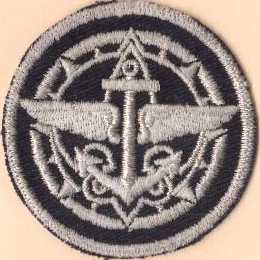 Outfit
Advisor Outfit
Advisor |
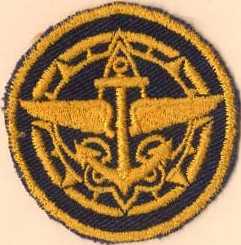 Assistant
Outfit Advisor Assistant
Outfit Advisor |
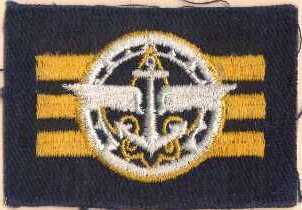 Outfit
Guide Outfit
Guide |
Assistant Outfit Guide, NO PICTURE |
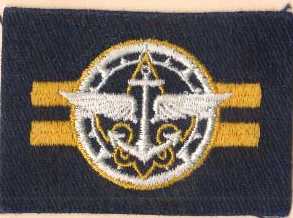 Crew
Leader Crew
Leader |
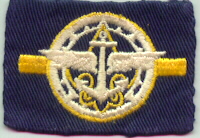 Assistant
Crew Leader Assistant
Crew Leader |
 Outfit
Secretary Outfit
Secretary |
Miscellaneous
Taking its inspiration from the Sea Scout program, National added the
use of "Standard Senior Scout Unit" awards. These awards were
given
to any Senior Scout unit which meet certain criteria at the local,
regional,
or national levels. The Sea Scouts started this around 1939, and
I think National picked it up for all the Senior Scout units around
1947.
In that year, the three Unit Awards said "1947" on them, afterwards the
year was dropped.
These awards would continue for some time, at least in the Sea
Scouts/Sea
Explorers. The latter day Honor Units/Quality Units for Cub, Boy
Scout, and Explorer units got its start in many way with this program.
| 1947 National Standard Senior Scout Unit |  |
1947 Local Standard Senior Scout Unit |
 |
Regional Standard Senior Scout Unit | Local Standard Senior Scout Unit |
Literature
Not alot of literature was produced on the Senior Scouting program.
The two Guidebooks on Senior Scouting were basically pamphlets on the
programs.
The Guide Book of Senior Scouting gives a decent overview of
the
Explorer Scout, Rover Scout, and Sea Scout programs, with some nice
detail
on the early programs. The later Senior Scouting Guidebook
gives
a very brief overview of the programs.
The Adventuring for Senior Scouts is the closest to a handbook for the Senior Scouting programs. However, its main focus is on the Explorer Scout program. It gives a very brief explanation of some of the other programs, but leaves those programs to their own manuals (Sea Scouts, Air Scouts, and supposedly Rover Scouts).
Program Notebooks were started I think in 1943, for all programs, including Senior Scouting. (Anyone have data on when they really started??).
The Hints on Senior Scout Leadership gives a brief intro to leadership in these programs, aimed at both youth and adults. They never produced something along the lines of the Scoutmaster Handbook for these programs, and the Hints are no replacement for it.
No National newsletter or magazine was produced for Senior Scouting
programs.
| The Senior Program Guide Book (#3442)
early 1935? Guide Book of Senior Scouting (#3442) 1935, Oct 1937 1938, January 3000 1941, March 3000 pamphlet, 72-76pg |
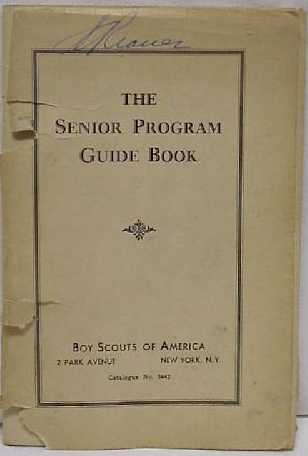 |
| Senior Scouting Guidebook (#3471)
1942, May 25000 1946, Jan 1946, Dec 15000 1947, May pamphlet, 62pg |
  |
| Adventuring for Senior Scouts (#3639)
Proof 1938 1st 1938 639p+10p 2nd 1939,Apr 10000439 3rd 1942,May 4th 1942,Jun 692p [revised 2nd printing] 5th 1944,Jun 687p 6th 1945,Apr 687p+8p [Air Scout added to cover] 7th 1946,Jan 686p+8p 5000146 hardcover book. edited by W.H. Hurt |
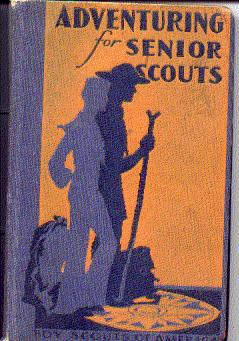 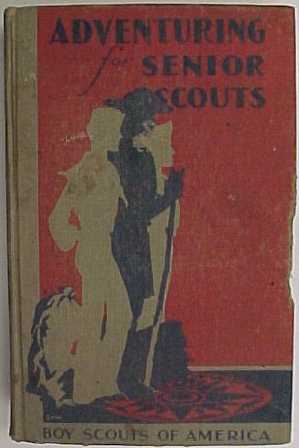 |
| Senior Scouting Program Notebook
1943 (shown) 1944 1945 (shown) 1946 (shown) 10000 1946-47 (shown) 1947-48 1948-49 (shown) 1949-50 (shown) 18000 booklet, 128pg |
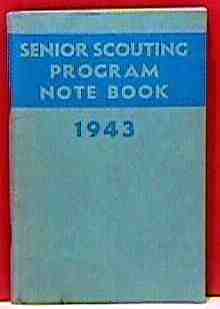 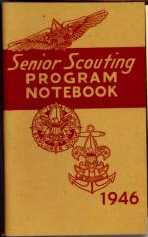 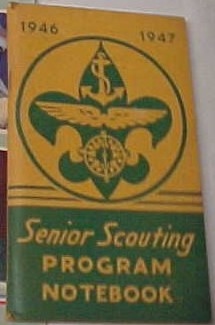 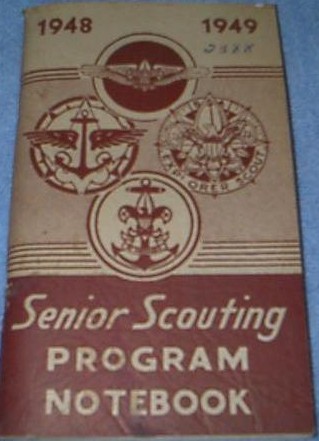 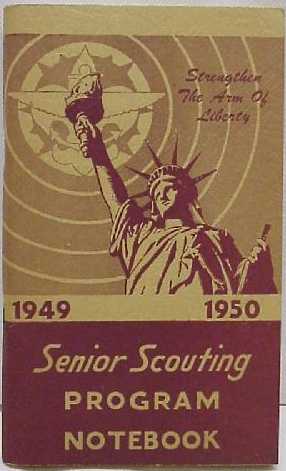 |
| Hints on Senior Scout Leadership (#3482)
1947 15000647 1948 1949 booklet, 94pg |
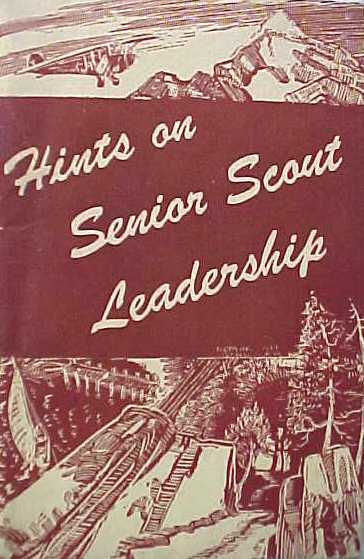 |
Updated: 02/11/2005mrb